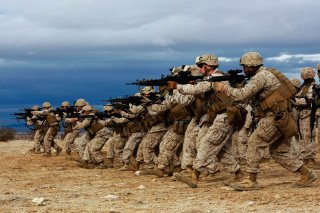The U.S. Marines Are The World's Best Amphibious Force, But That May Not Remain True For Long
Training problems must be remedied.
Here's What You Need To Remember: The U.S. Marine Corps is turning to virtual training, which would allow units to simulate—at least to some agree—amphibious training even when ships aren’t available. However, GAO faulted the virtual effort for lack of consideration of what tasks marines would train in, available time for training, and how to measure whether virtual training works.
The U.S. Marine Corps is arguably the best amphibious-warfare force in the world. But a new Government Accountability Office report suggests that lack of training may be eroding the marines’ amphibious capabilities.
The problem isn’t with the marine amphibious units deployed at sea, which would be at the forefront of the fighting should war erupt in Korea or the South China Sea. The issue is that relentless overseas commitments have strained marine resources so badly that it can’t conduct the other training that it needs to maintain its combat edge.
A review of readiness data from 2014 to 2016 revealed that “Marine Corps units were unable to fully accomplish training for other amphibious operations priorities,” according to the GAO report. “These shortfalls include home-station unit training to support contingency requirements, service-level exercises, and experimentation and concept development for amphibious operations.”
Recommended: Uzi: The Israeli Machine Gun That Conquered the World
Recommended: The M4: The Gun U.S. Army Loves to Go to War With
Recommended: Why Glock Dominates the Handgun Market (And Better than Sig Sauer and Beretta)
The prime reason was lack of enough amphibious ships to sustain overseas deployments and conduct home-station training. All twenty-three marine units interviewed by GAO researchers listed lack of ships as their biggest training problem. The U.S. Navy’s fleet of amphibious ships has plummeted from sixty-two in 1990 to thirty-one today, though there are plans to add four new vessels by 2024.
In addition, seventeen of the twenty-three units complained that they couldn’t train because of lack of access to training ranges, especially with units scheduled to deploy getting first crack at training facilities. Almost half said training was hampered by maintenance work on ships, bad weather or the transit time it took for the amphibious ship to reach the training area. Curiously, only five of twenty-three marine units reported that deployments, or the need to prepare for upcoming deployments, actually affected their training.
On the surface, this seems like yet another post-9/11 symptom of too many U.S. military commitments and not enough resources. But GAO also faults the U.S. Marine Corps and Navy for the problem. For example, when navy amphibious ships are freed up for training, the marines send whatever units are available rather than those who should get priority.
Nor has either service taken advantage of alternatives to the shipping shortage. “These alternatives could include utilizing additional training opportunities during an amphibious ship’s basic phase of training; using alternative platforms for training, such as Marine Prepositioning Force ships; utilizing smaller Navy craft or pier-side ships to meet training requirements; and leveraging developmental and operational test events,” GAO said.
The U.S. Marine Corps is turning to virtual training, which would allow units to simulate—at least to some agree—amphibious training even when ships aren’t available. However, GAO faulted the virtual effort for lack of consideration of what tasks marines would train in, available time for training, and how to measure whether virtual training works.
Michael Peck is a contributing writer for the National Interest. He can be found on Twitter and Facebook. This first appeared in 2018.
Image: Flickr.

